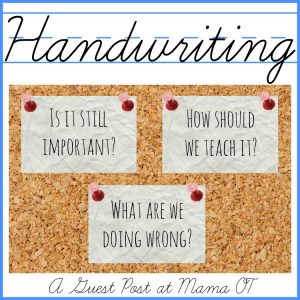
Apple, once again went viral when they released the newest iPhone model last September. While sometime in June Microsoft made it to the headlines launching Surface Laptop to the market. Apple and Microsoft are considered today’s tech giant in the world. Alongside other tech companies, they innovate, create, and produce gadgets that make our lives more comfortable and easier. Our fingers are becoming more powerful each day. Today, indeed, is the age of technology.
With all these wonderful inventions come the great question, “is handwriting still important?”
Children, nowadays, are widely exposed to gadgets. The slight touch of their cute-little-tiny fingers on the screen of their powerful gadgets plus the accessibility of computers in school enables their innocent minds to discover the endless possibilities of the world. But this exposure may be one of the causes of poor handwriting among the children. And poor handwriting is a common reason for referral to school-based occupational therapy.
Sharing to you is an excerpt from the interview of Christie of http://www.mamaot.com/, a well-established OT blogger with posts targeted at educating and empowering those who care for children, her posts cover the span from infancy to elementary age, with Dr. Beverly Moskowitz, an occupational therapist, an expert in the field of school-based practice, and creator of a relatively new approach to handwriting.
Dr. Moskowitz provided a compelling post on why we still need to teach handwriting (even in this age of technology), how occupational therapists typically work on handwriting, and why we may need to re-think that approach.

Mama OT: In this age of technology, is handwriting really that important?
Dr. Moskowitz: Yes. But you’re not alone in questioning it. The prevalence of computers in our classrooms and the potential they have to transcribe volumes of work in record times has led many to believe that handwriting is antiquated and that handwriting instruction an unnecessary use of time. But here are the facts:
1. Handwriting is not a self-evident skill. Normal development and the passing of years don’t insure that students will acquire habits and patterns that are either efficient or effective. This is confirmed by the research. Children may be able to make letters that are recognizable in isolation or small groups. But in time when speed and volume are factors, their appearance often deteriorates significantly.
2. Keyboarding is not a faster skill. In fact, research has shown that children write more words and do so more quickly in grades 2, 4 and 6 when they print them than when they type. Furthermore, handwriting instruction supports automaticity, speed and output. In other words, when children have the skills to print legibly and neatly, they write more and they write faster.
3. The manual task of handwriting stimulates centers of the brain associated with learning, memory, creativity and more. MRI studies show a clear difference between students taught to print and those visually shown letters. In one of the neuroimaging studies by Dr. Karin James from Indiana University, four weeks of each approach showed a marked contrast in the electrical activation of the brain. Students who were instructed and practiced printing had brain maps illuminated comparably to that of adults. In comparison, there was no change in the electrical activity for children simply regarding letters. The implication is that the brain is exponentially engaged during the process of printing. These measurable results and imaging pictures argue forcefully for the inclusion of printing instruction as the process itself helps reinforce early learning.
4. Writing letters by hand has been proven to help children recognize and remember letters more easily than if they typed them. Compounding the argument for the importance of putting pencil to paper are studies that show heightened neural stimulation during printing versus keyboarding. In addition, students remember less when typing as compared to while printing.
Mama OT: In my experience working as an occupational therapist, I’ve found that handwriting is one of the main reasons students are referred to OT for screenings and assessments in the school-based setting. Why do you think that is?
Dr. Moskowitz: There are several reasons for this. The easiest is the prevalent but erroneous belief that printing is a self-evident skill and that instruction is therefore not needed. Strangely, that philosophy is often paired with a popular linguistic philosophy that encourages students to write without attention to the mechanical aspect, as if doing so would dampen the love of immortalizing thoughts onto paper. These romantics seemed convinced that students couldn’t handle correction. It is no small coincidence then that surveyed teachers admitted to not being comfortable with handwriting instruction. In fact, only 12% noted that they’d had any formal background in the subject. That lack of understanding has led many to assume that printing could be mastered by simply completing worksheets independently after all other work is done. Together, along with the overall economic cutbacks confronting school districts across the country, many administrators deem as superfluous the consumable workbooks required by most handwriting instructional programs. In turn, districts are forced to make hard choices. Services, subjects, personnel and more are put on the chopping block. But as if all of the above was not enough to discourage even the most stalwart of handwriting instruction supporters, the mandates to differentiate instruction, obtain voluminous data, intercede at the earliest signs of struggle and procure proficiency scores on all local, state and national tests, have forced teachers to cry ‘uncle.’ They’ve just run out of time. They are often unable to cover curriculum aside from that required by tests used to determine future funding. In fact, it feels like No Child Left Behind has actually left a lot of curriculum behind…handwriting being one of them.
Mama OT: In your experience, what do OTs most often focus on when working on handwriting with students?
Dr. Moskowitz: OTs are nothing if not holistic. We’ve been trained to be analytic, comprehensive, methodical and inventive in evaluating, treating and documenting our treatments. Toward that end, we have relied on the wealth of theories that have informed our understanding of development, perception, motor skills and cognition. And being the professionals that we are, it stood to reason that we’d apply equal zeal in addressing all of the deficits, building the foundation skills and layering on accommodations identified by allied professions and our own ingenuity. The problem is not that we have not been diligent, consistent or deferential to the literature. Lots of therapists are using marvelous techniques, energy and wisdom to plug in all the holes, to remediate perceptual delays of visual discrimination and spatial relations, to strengthen the core and maximize in-hand manipulations. Traditional approaches to instruction based on the formation of letter shapes pervade the existing options and our orientation to the issue. We’ve been cognizant of logical times to push-in support, like handwriting instructional time. Plus, our students are seen regularly. Yet we acknowledge as a group that carryover and follow through are ongoing concerns.
For more of the informative interview, you can find them here.
If you’re curious about the effectiveness of School-Based Occupational Therapy intervention on handwriting, AOTA published a research article here.



